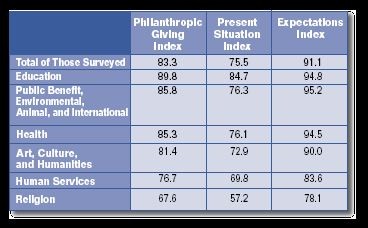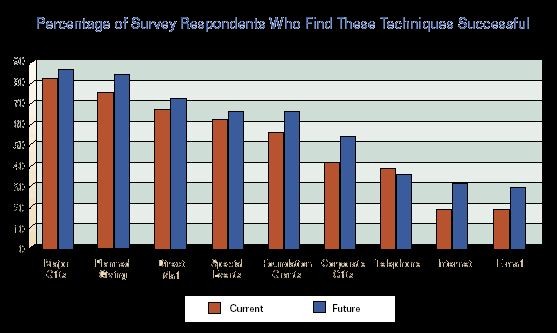The Center on Philanthropy at Indiana University’s recently released Philanthropic Giving Index (PGI) holds good news for gift planners. After the PGI reported a five-year low in fund-raising confidence this summer, the December 2003 report contains the greatest six-month increase in the PGI’s history and the greatest 12-month increase since December 2002. See the Center on Philanthropy’s Web site at www.philanthropy.iupui.edu/PGI-Dec2003.pdf for the complete report.
What does the PGI measure?
The Center on Philanthropy has been conducting these periodic surveys of the nation’s fundraisers since 1998. Intended to gauge confidence among those engaged in nonprofit fund development, the survey is mailed to a cross-section of the nation’s fund-raising executives and consultants representing a broad range of charities of various sizes, geographical locations, and levels of revenue.
The survey asks respondents not only to comment on the present fund-raising environment but also to predict the climate for fund-raising success in the upcoming six months. The average of these two is then reported as the overall PGI. Higher numbers indicate increased confidence.

As was mentioned previously, the December 2003 survey reported notable improvements in fundraisers’ opinions about the present fund-raising situation, their expectations for the next six months, and the overall PGI. These most recent results revealed especially significant increases from the Summer 2003 report: a 15.2% increase in the overall PGI, a 19.8% increase in the Present Situation Index, and an 11.7% increase in the Expectations Index. See chart on the right for the results of the most recent PGI.
It’s the economy
The Center on Philanthropy attributes this increase in confidence to the corresponding improvement in the nation’s economy in the latter half of 2003. The S&P 500 Index rose about 10% in the six-month period from the spring of 2003, the reporting period for the Summer 2003 PGI survey, to October 2003, when the current PGI poll was performed. Additionally, the nation saw an increase in the level of personal income and corporate pre-tax profits during those months.
The economic improvement was reflected in the December 2003 PGI results. The Summer 2003 survey showed that 73.7% of those surveyed held a negative opinion about the impact of the economy on fund raising and that 42.5% predicted that the negative impact would continue for the next six months.
Compare those numbers with those taken from the December report, which shows a 20-point decline in fundraisers holding a negative opinion of the current economy and an 18-point decline in those who predict a negative impact in the next six months. Well over half of those surveyed in the December report (61.4 %) predict that the economy over the next six months will have a positive or very positive impact on the future of fund raising.
Just in the short time since October, the S&P 500 has increased about another 10% and the Dow has surged to a level well above 10,000. With no indication of an imminent decline, gift planners have good reason to feel confident that a solid economy will translate into increased gifts, both planned and immediate, in the near future. Not surprisingly, a number of institutions are now reporting a sharp increase in gifts of securities in the final months of 2003.
Good news for planned giving
As has been the case in the past, fundraisers once again listed planned giving among the most successful fund-raising techniques, along with major gifts. Almost three-quarters of respondents (73.8%) currently listed planned giving as a successful or somewhat successful way to raise funds, and 81.8% feel that it will continue to be in the next six months.
Organizations with annual revenues exceeding $10 million found the most success with planned giving, as did those with either a regional or a national donor base.
Fundraisers feel somewhat less confident about future prospects for other common fundraising techniques, as is reflected in the chart below.

It is interesting to note that the only fund-raising technique that development executives foresee as being less successful in the next six months is marketing by telephone. As previously mentioned in Give & Take, the National Do Not Call list does not apply to nonprofits. However, fundraisers are wise to anticipate a decline in the effectiveness of unsolicited telephone calls. Those on the receiving end are unlikely to know or care that nonprofits have been excluded from the ban, and unwanted phone calls can thus be expected to elicit a chilly response in some cases.
How different organizations fared
In general, the nation’s educational institutions felt the most confidence in all three aspects of the survey while religious institutions felt the least optimistic. See first chart above.
What does it all mean?
The December Philanthropic Giving Index bodes well for the immediate future of fund raising in general and planned and major gifts in particular. The dramatic increase from the Summer 2003 report indicates that fundraisers have reason to feel increased confidence—presumably because of a corresponding increase in the number of gifts and inquiries received over that period.
In summary, all indicators point to increased success in the next six months. Almost two-thirds of those surveyed feel that the economy will encourage donors to give, and present economic indicators point to a stable economy in the near future.
This year has also ushered in a number of tax changes that should bode well for fund-raising success. The increase in the estate tax exemption and a decrease in estate and gift tax rates may mean more interest in gifts that provide income tax savings, increased spendable income, and other immediate benefits. These tax changes will also lead many donors to reevaluate their financial and estate plans, and many may decide to include a bequest to a favorite charitable organization now that less may be due in taxes and more funds will consequently be available for other heirs.
Wise fundraisers will see an opportunity this spring to take advantage of a favorable economy and the general optimism to help ensure their organization’s future stability. Sharpe’s latest seminar offering, “Strategic Gift Planning 2004,” is designed to help experienced fundraisers recognize and capture the unique fund-raising opportunities presented this year. Visit www.sharpenet.com/training for details.

